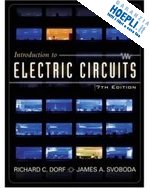
Questo prodotto usufruisce delle SPEDIZIONI GRATIS
selezionando l'opzione Corriere Veloce in fase di ordine.
Pagabile anche con Carta della cultura giovani e del merito, 18App Bonus Cultura e Carta del Docente
Professor Dorf has extensive experience with education and industry and is professionally active in the fields of robotics, automation, electric circuits, and communications. He has served as a visiting professor at the University of Edinburgh, Scotland, the Massachusetts Institute of Technology, Stanford University, and the University of California at Berkeley.
A Fellow of the Institute of Electrical and Electronic Engineers and the American Society for Engineering Education, Dr. Dorf is widely known to the profession for his Modern Control Systems, tenth edition (Prentice Hall, 2004) and The International Encyclopedia of Robotics (Wiley, 1988). Dorf is also the coauthor of Circuits, Devices and Systems (with Ralph Smith), fifth edition (Wiley, 1992). Dr. Dorf edited the widely used Electrical Engineering Handbook, third edition (CRC Press and IEEE Press), published in 2005. His latest work is Technology Ventures (McGraw–Hill, 2005).
James A. Svoboda is an associate professor of electrical and computer engineering at Clarkson University, where he teaches courses on topics such as circuits, electronics, and computer programming. He earned a Ph.D. in electrical engineering from the University of Wisconsin at Madison, an M.S. from the University of Colorado, and a B.S. from General Motors Institute.
Sophomore Circuits is one of Professor Svoboda's favorite courses. He has taught this course to 4500 undergraduates at Clarkson University over the past 26 years. In 1986, he received Clarkson University's Distinguished Teaching Award.
Professor Svoboda has written several research papers describing the advantages of using nullors to model electric circuits for computer analysis. He is interests in the way technology affects engineering education and has developed several software packages for use in Sophomore Circuits. Professor Svoboda's email address is svoboda@clarkson.edu and the url of his web page is http://www.clarkson.edu/svoboda/.











Il sito utilizza cookie ed altri strumenti di tracciamento che raccolgono informazioni dal dispositivo dell’utente. Oltre ai cookie tecnici ed analitici aggregati, strettamente necessari per il funzionamento di questo sito web, previo consenso dell’utente possono essere installati cookie di profilazione e marketing e cookie dei social media. Cliccando su “Accetto tutti i cookie” saranno attivate tutte le categorie di cookie. Per accettare solo deterninate categorie di cookie, cliccare invece su “Impostazioni cookie”. Chiudendo il banner o continuando a navigare saranno installati solo cookie tecnici. Per maggiori dettagli, consultare la Cookie Policy.